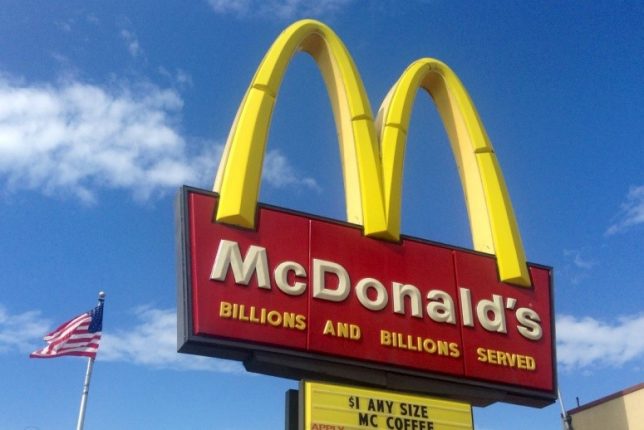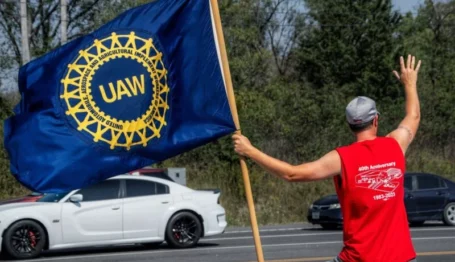Labor Watch
SEIU’s Fight for $15 and the Anatomy of a Union Campaign
 General Counsel Griffin filed charges against McDonald’s USA, the corporate parent of McDonald’s franchises, holding it liable for the labor law actions of its franchises—exactly in accordance with the SEIU’s plan to advance Fight for $15 and contrary to all prior NLRB precedent. Credit: Mike Mozart. License: https://goo.gl/WBxDZP.
General Counsel Griffin filed charges against McDonald’s USA, the corporate parent of McDonald’s franchises, holding it liable for the labor law actions of its franchises—exactly in accordance with the SEIU’s plan to advance Fight for $15 and contrary to all prior NLRB precedent. Credit: Mike Mozart. License: https://goo.gl/WBxDZP.

Since 2012, the Service Employees International Union (SEIU) and its affiliates may have spent over $180 million on the so-called Fight for $15 campaign to raise the minimum wage and unionize restaurants. This estimate, commissioned by the International Franchise Association (IFA), was based on the annual reports that the SEIU and its subordinate unions filed with the U.S. Department of Labor, pursuant to the Labor Management and Reporting and Disclosure Act of 1959.
This union transparency law recently turned 60, and the Labor Department has proposed expanding reporting requirements to the “intermediate bodies” of government worker unions. These reports can help the general public and interested observers piece together just how a “corporate campaign” such as the Fight for $15 operates.
Corporate Campaigns
But before one gets there, first recall what a “corporate campaign” is.
The SEIU prefers not to secure monopoly representation privileges (“unionization” of a workplace) by a secret-ballot vote, not least because it can lose a secret-ballot vote. Instead, it prefers the “card check” under a “neutrality agreement”—public solicitation of employee signatures on union membership cards that the employer concedes to take as evidence of union support. This is easier for a union because the employer does not present union-skeptical arguments to employees to rebut the union’s sales pitch and because the public solicitation enables union supporters and organizers to publicly pressure workers skeptical of unionizing without giving the skeptics a private place to make their true feelings known.
But to get to the “neutrality agreement,” the employer must agree to give up its rights and the rights of its employees. To secure that concession, the union targets the employer’s brand and good name with a “corporate campaign.”
The Fight For $15 Campaign
Fight for $15 is a classic corporate campaign with a twist: The target corporation (McDonald’s first, other quick-service restaurants later) must first control the workers the union wants to organize. In the case of quick-service restaurants, the workers typically work for independent franchisees. The SEIU’s “solution” was to tie the corporate campaign to a legal campaign, pushing the Obama administration–nominated National Labor Relations Board to recognize the national brands as “joint employers” with the local franchises. The union had identified joint employer liability to pressure the national brands to agree to “neutrality agreements,” easing the path to massive unionization campaigns and potentially hundreds of millions in annual union revenues from dues and mandatory fees.
That raises the question of how much the SEIU has spent on its effort. Critics of the union have tracked the union’s expenditures on grants to “worker centers” and left-progressive agitation groups that support union campaigns. The SEIU has also paid media consultants such as BerlinRosen, who orchestrated the “fast food strikes,” which were an important part of the early corporate campaign. (The Associated Press reported on the “strikes,” observing that “it wasn’t clear how many [fast-food-strike] participants were fast-food workers, rather than campaign organizers, supporters or members of the public relations firm that has been coordinating media efforts.”) The SEIU also has spent money setting up “worker organizing committees,” proto–labor unions, which have been replaced by the SEIU-affiliated National Fast Food Workers Union to represent the soon-to-be-unionized workers.
As of 2017, observers estimated SEIU had spent $90 million on the campaign. After adding up spending by lower-level SEIU unions, SEIU expenditures in 2018, and spending on law firms at home and abroad, the IFA-commissioned report estimated that total spending has exceeded $180 million. With these two estimates as upper and lower bounds, the SEIU has clearly spent enormous sums of money on the corporate campaign.
What’s the Objective?
And for what? The SEIU has won a few legislative victories in deeply union-favorable jurisdictions such as Seattle and New York, but the National Fast Food Workers’ Union reported no members as of 2018, and the Trump administration–nominated National Labor Relations Board has issued a rule restoring the longstanding precedent on joint employer that the union wanted overturned.



